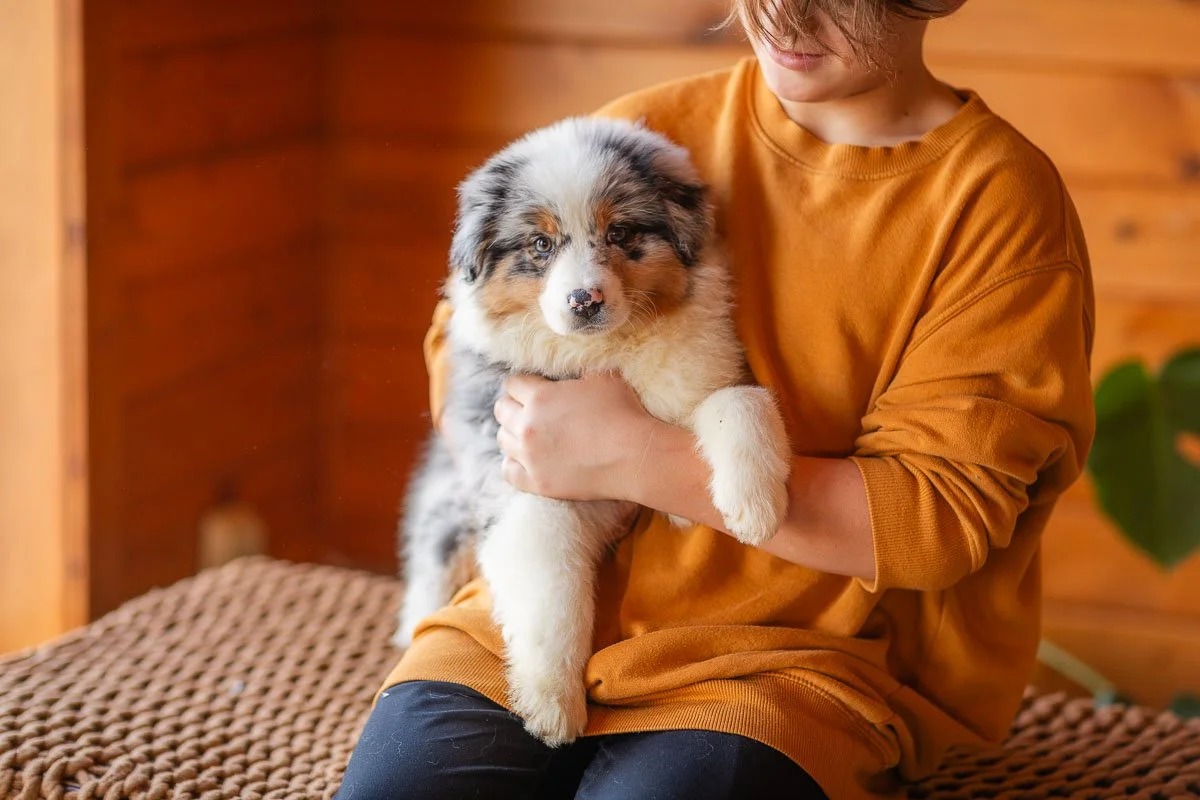From Nips to Nuzzles: Training Calm Mouths in Doodle Puppies
Welcoming a Stokeshire puppy into your home is a joyful milestone—one filled with cuddles, discovery, and yes, those sharp little teeth.
Puppy mouthing is completely normal, especially in intelligent and emotionally attuned breeds like Aussiedoodles, Bernedoodles, and Bernese Mountain Dog crosses (also known as Aussie Bernese or Australian Mountain Dog). With a blend of curiosity, strength, and sensitivity, these breeds experience the world with their mouths—and often your fingers.
But just because it’s expected doesn’t mean it should go unaddressed. In fact, how you respond in these early weeks lays the foundation for calm, respectful behavior for years to come.
If you’ve found yourself with a teething tornado at your heels, you’re not alone. Let’s walk through what mouthing means—and what you can do to guide your hybrid pup through this phase with confidence and kindness.
Why Do Puppies Mouth?
Puppies experience the world through their mouths. Just like toddlers explore by touching, puppies chew and nibble to learn, soothe, and engage.
Teething Relief: Puppy teeth erupt around 3–4 weeks and continue developing through 6 months. Mouthing helps ease the discomfort.
Exploration & Communication: Puppies mouth each other and their surroundings to bond, explore, and establish social rules.
Play: Within the litter, mouthing teaches boundaries. What’s too rough? What earns attention? What ends the game?
At Stokeshire, we start teaching bite inhibition and boundary awareness from day one with the help of their mother and siblings and some of our “auntie moms”. But once your puppy is home, it’s your turn to carry that torch forward with consistency, structure, and calm leadership.
Why Smart Puppies Can Be Mouthy
Breeds like Aussiedoodles & Australian Mountain Doodles, and Poodle crosses are incredibly intelligent, emotionally attuned, and eager to please, which is why they’re such a joy to train. But with that brilliance often comes a heightened need to explore and communicate, especially during puppyhood. Mouthing is one of the ways these pups process their environment, relieve teething discomfort, and interact socially. It’s not a flaw—it’s a sign of a thinking, feeling puppy trying to connect like it would with its siblings. With consistent guidance, structure, and redirection, their natural mouthiness becomes an opportunity to shape impulse control, deepen trust, and build a foundation for lasting companionship.
Teaching Bite Inhibition
Bite inhibition is your puppy’s ability to control the strength of their bite—and it’s one of the most important lessons they’ll ever learn. Especially with powerful breeds like Bernese Mountain Dogs or active minds like Aussiedoodles, this step is essential.
How to Begin:
Mimic the Litter Response: When your puppy bites too hard, let out a quick, high-pitched “ouch!” or “nope!”—then pause interaction.
Stop the Fun: If they persist, calmly walk away or offer a crate break. No drama, no scolding—just a clear message.
Be Consistent: Everyone in the household should use the same technique. Mixed signals lead to confused puppies and slower progress.
Your puppy will soon realize: gentle mouths = continued play.
Proven Strategies to Curb Mouthing
1. Redirect with Purposeful Play
Aussiedoodles & Australian Mountain Doodles, and other doodle breeds crave mental stimulation. Without redirection, their brains (and mouths) get creative.
Offer Chew Variety: Think frozen Kongs, rope toys, durable rubber chews, and food puzzles.
Size Up for Bernese Mixes: These pups have strong jaws—avoid plush toys and flimsy materials.
Teach Safe Tug Games: Tug-of-war is great—just teach a solid “drop it” and keep your hands away from their mouths.
2. Honor the Power of Rest
Most mouthing spikes when puppies are overtired or overstimulated.
Establish a Nap Routine: Puppies need 16–18 hours of sleep daily. Without it, they get cranky—just like toddlers.
Create Calm Spaces: Use crates, pens, or quiet corners to help them decompress after play or meals.
3. Use Gentle Time-Outs
If redirection fails, give them space to reset.
Keep It Short: A calm, 1–2 minute break in a crate or gated area is often enough.
Don’t Escalate: No yelling or grabbing—your stillness and silence send a stronger message.
4. Offer Frozen Teething Relief
When teething peaks, offer soothing alternatives:
Frozen carrots
Ice cubes in a washcloth
Kongs stuffed with plain yogurt or pumpkin, then frozen
Aussie mix puppies benefit from these even more, since they need both oral comfort and something stimulating to focus on.
Stand Like a Tree (and Let Them Discover Too)
When your puppy's mouthing escalates, moving can unintentionally encourage more nipping. Instead, stand still like a tree:
Freeze in place, avoid eye contact, and quietly disengage until they release or lose interest
As soon as they stop mouthing—even briefly or by sitting—younger puppies can be rewarded with praise or a treat to reinforce calm behavior
This technique mimics littermate correction through inaction, showing “nipping = boring human.”
Redirect to Self-Mouthing
Allowing a puppy to mouth on themselves—such as lightly tugging on their fur or ears—teaches bite inhibition naturally
When they switch focus from human skin to their coat, gently refine behavior with soft praise and redirect to a chew toy.
“Ouch!” The Classic Yelp
When your pup bites too hard, a sharp “Ouch!” or high-pitched yelp interrupts the behavior by simulating a hurt littermate . This pause in play gives you a moment to:
Freeze in place or step away silently.
Offer a chew toy.
Begin offering positive reinforcement when they engage appropriately.
Over time, this teaches your puppy to associate hard bites with an end to play and rewards them for gentler mouthing.
In essence:
Staying as calm and still as a tree, guiding them to self-mouthing, and reinforcing hard-bite feedback with a yelp—all work together to help puppies, especially intelligent Bernedoodles and Aussiedoodles, learn bite control with confidence and kindness.
Puppy + Kids: Keep It Safe with Calm Moves
Young children—especially those under age 6—can unintentionally spark a puppy’s prey drive by running, squealing, or darting around. To a young Bernedoodle or Aussiedoodle, that can look like prime chase game material. Instead, teach your kids to “stand like a tree”: freeze in place with arms at their sides when the puppy approaches. This helps them avoid looking like prey.
Encourage children aged 4–10 to walk slowly past the puppy, quietly talking or carrying a treat or toy. This lets the puppy associate calm movements with rewards, not the excitement of a chase . If your puppy starts nipping at pant legs, parents should intervene calmly, stepping between the puppy and child or guiding the dog to a safe, quiet space—no shouting or scolding, just neutral redirection.
Teaching children to stay grounded and follow gentle guidance helps prevent early predatory habits, and builds respect-based bonds between your puppy and its little people.
Tethering & Teaching “Place”: Creating Calm Through Structure
For puppies who struggle with impulse control—especially during high-energy windows—tethering and teaching “place” are powerful tools for reinforcing calm behavior in a structured way.
Tethering simply means using a leash to limit your puppy’s freedom in a controlled area. We often recommend clipping their leash to a sturdy object while they’re supervised. This can be especially helpful during busy family routines (like meals or school drop-offs) when your puppy might otherwise be underfoot or overstimulated. Give them a chew toy or frozen treat to settle in calmly. Over time, they’ll associate this downtime with safety and predictability.
Teaching “place” involves training your puppy to go to a designated spot (like a raised cot or dog bed) and stay there until released. We begin this foundational cue at Stokeshire during Doodle School using food rewards, leash guidance, and repetition. For puppies prone to nipping during overstimulation, “place” becomes their anchor—where they learn to regulate themselves and receive praise for calm behavior.
When redirection or verbal correction alone isn’t effective, we may introduce a slip lead to apply gentle directional pressure, guiding your puppy into the desired behavior, like sitting or settling. The key is timing, consistency, and calm follow-through. We never jerk, yank, or use force—pressure is paired with praise and released as soon as the puppy responds.
In rare cases of persistent biting, boundary-pushing, or fixated behavior, our lead trainer, Karlee, may introduce e-collar conditioning as part of a long-term training plan. These are not used for punishment, but rather as a communication tool to reinforce known commands and interrupt fixation. E-collars are introduced gradually, at low levels, and paired with positive reinforcement, often in situations where other methods have failed or the puppy’s safety is at risk.
At Stokeshire, we believe in calm, consistent leadership, not intimidation. Tools are never a replacement for relationships, but when used correctly, they can enhance communication, increase safety, and empower both puppies and families to thrive together.
Professional Support Makes a Difference
While at-home consistency is essential, pairing it with structured guidance gives your puppy the best of both worlds.
Group Classes: Build foundational commands and practice manners in real-life settings.
Private Coaching: Ideal for pups with persistent mouthing or unique temperaments.
Your Stokeshire Start: Remember, all Stokeshire puppies come home with an imprinting foundation. Our Doodle School pups are already familiar with crate naps, name recall, and respectful play cues.
In Closing
Mouthing is a season, not a sentence. With clear boundaries, calm redirection, and lots of rest and love, your puppy will learn what’s okay to bite—and what’s better left alone.
You’ve got this. And we’re always here to help.
Because that little mouthing tornado at your feet? With time and training, they grow into the dog who walks gently by your side—loyal, trusting, and totally in tune with you.
References
American Kennel Club. (2025, January 10). Expert tips to curb puppy mouthing. AKC. https://www.akc.org/expert-advice/training/puppy-mouthing-expert-tips/ American Kennel Club
American Kennel Club. (2023, May 5). How to train a Bernese Mountain Dog puppy: Milestone timeline. AKC. https://www.akc.org/expert-advice/nutrition/train-bernese-mountain-dog-puppy-milestone-timeline/ American Kennel Club
American Kennel Club. (2024, February 15). Puppy nipping: How to stop a puppy from biting. AKC. https://www.akc.org/expert-advice/training/puppy-stop-nipping/ American Kennel Club
American Kennel Club. (2021, June 4). How to stop a puppy from biting and train bite inhibition. AKC. https://www.akc.org/expert-advice/training/stop-puppy-biting/ American Kennel Club
Spruce Pets. (2018, December 7). Bernese Mountain Dog (Berner): Characteristics & care.



